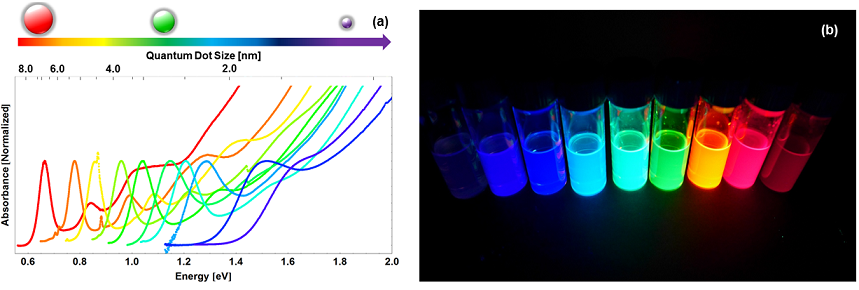Semiconductor quantum dots (QDs) are nanometer-sized particles which can be considered as the intermediate species between the molecular and bulk form of matter. In particular for optoelectronic application QDs are unique as their optical properties (absorbance and emission) can be customised by simple adjustments of the crystallite’s physical dimension. This phenomenon can be understood as a consequence of the quantum confinement effect which restricts the extension of the Bohr exciton of the parental bulk material within the spatial boundaries of the QD. It follows that a decrease in QD size is accompanied by a blue shift in optical absorbance and emission (see Figure 1).

Figure 1: Absorbance spectra of a series of different sized PbSe QDs (a) and solution flourescence of perovskite QDs of different size and composition (b).
Beside the benefit of tuning the optical bandgap by changing the particle size, QDs also hold the promise of a low threshold energies for charge carrier multiplication mechanisms such as multiple exciton generation (MEG). It follows that solar cells fabricated from QDs can exploit MEG from rather low energy photons (visible spectral region) thereby enabling the harvest OF multiple charge carriers from a single excitation. In recent work we demonstrated that MEG can indeed be exploited in PbSe nanorod and PbTe QD-based devices and that the MEG contribution to the overall photocurrent can exceed 10% (see Figure 2). 1,2

Figure 2: External Quantum efficiency of PbSe nanorod (a) and PbTe QD (b) based devices. External quantum efficiencies exceeding 100% can be considered as an unambiguous evidence that multiple charge carrier pairs are harvested from a single excitation.1,2
In a more indirect way, QDs can also assist other carrier multiplication mechanisms (i.e. singlet fission) to convert excitons into free charges. In conjunction with e.g. silicon solar cells highly efficient, commercially available solar cells can be supplemented by materials which are able to convert one high energy photon into multiple charge carrier pairs (link to the Singlet Fission part).3)
1) N.J.L.K.Davis, M.L.Böhm, M. Tabachnyk, F. Wisnivesky-Rocca-Rivarola, T.C.Jellicoe, C.Ducati, B.Ehrler, N.C.Greenham Nat.Commun. 2015 10.1038/ncomms9259
2) M.L.Böhm, T.C.Jellicoe, M. Tabachnyk, N.J.L.K.Davis, F. Wisnivesky-Rocca-Rivarola, C.Ducati, B.Ehrler, A.A.Bakulin, N.C.Greenham Nano Lett. 2015 10.1021/acs.nanolett.5b03161
3) B.Ehrler, K.P.Musselman, M.L.Böhm, R.H.Friend, N.C.Greenham Appl.Phys.Lett. 2012 10.1063/1.4757612
